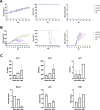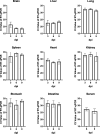Neonatal mouse model reveals pathogenesis of Shanxi Tick Virus 2 isolated from Haemaphysalis longicornis
- PMID: 40640816
- PMCID: PMC12243325
- DOI: 10.1186/s12985-025-02825-4
Neonatal mouse model reveals pathogenesis of Shanxi Tick Virus 2 isolated from Haemaphysalis longicornis
Abstract
Shanxi Tick Virus 2(SXTV2), a Tamdy group member of Orthonairovirus genus, Nairoviridae family, was initially identified through Next Generation Sequencing, with its pathogenicity and risk profile remaining unclear. This study reports the first successful isolation of SXTV2 from Haemaphysalis longicornis ticks collected from Hunchun City, China-a tri-border region between China, Russia, and North Korea. The isolated SXTV2 strain replicated and produced cytopathic effects in both Vero (primate) and SW-13 (human) cell lines. Electron microscopy revealed that SXTV2 particles are enveloped, surface-spiked, pleomorphic, and approximately 100 nm in diameter. Experimental inoculation in neonatal mice led to significant weight loss, liver injury and 100% mortality. In conclusion, this study marks the first successful isolation of the SXTV2 strain and exploring the animal model for member of Tamdy group orthonairovirus. These findings suggest the need for enhanced surveillance of SXTV2 zoonotic exposure and disease epidemic risks.
Keywords: First isolation; Neonatal mouse lethality; Orthonairovirus; Shanxi Tick Virus 2.
© 2025. The Author(s).
Conflict of interest statement
Declarations. Ethics approval and consent to participate: Animal experiments were approved by the Ethics Committee of the National Institute for Viral Disease Control and Prevention, Chinese Center for Disease Control and Prevention (approval number: bdbs20240326032). Consent for publication: Not applicable. Competing interests: The authors declare no competing interests.
Figures





Similar articles
-
Interspecies co-feeding transmission of Powassan virus between a native tick, Ixodes scapularis, and the invasive East Asian tick, Haemaphysalis longicornis.Parasit Vectors. 2024 Jun 15;17(1):259. doi: 10.1186/s13071-024-06335-0. Parasit Vectors. 2024. PMID: 38879603 Free PMC article.
-
Smelly communication between haemaphysalis longicornis and infected hosts with indolic odorants: A case from severe fever with thrombocytopenia syndrome virus.PLoS Negl Trop Dis. 2025 Jun 5;19(6):e0013139. doi: 10.1371/journal.pntd.0013139. eCollection 2025 Jun. PLoS Negl Trop Dis. 2025. PMID: 40472053 Free PMC article.
-
Microbiome diversity in Haemaphysalis flava (life stage-host dependent) and Haemaphysalis longicornis ticks with zoonotic implications in Nantong, China.Acta Parasitol. 2025 Jul 2;70(4):142. doi: 10.1007/s11686-025-01088-x. Acta Parasitol. 2025. PMID: 40601071
-
Tick-Borne Diseases in Sub-Saharan Africa: A Systematic Review of Pathogens, Research Focus, and Implications for Public Health.Pathogens. 2024 Aug 17;13(8):697. doi: 10.3390/pathogens13080697. Pathogens. 2024. PMID: 39204297 Free PMC article.
-
Exploring the diversity of tick-borne pathogens: The case of bacteria (Anaplasma, Rickettsia, Coxiella and Borrelia) protozoa (Babesia and Theileria) and viruses (Orthonairovirus, tick-borne encephalitis virus and louping ill virus) in the European continent.Vet Microbiol. 2023 Nov;286:109892. doi: 10.1016/j.vetmic.2023.109892. Epub 2023 Oct 15. Vet Microbiol. 2023. PMID: 37866329
References
Publication types
MeSH terms
Associated data
- Actions
- Actions
Grants and funding
LinkOut - more resources
Full Text Sources

